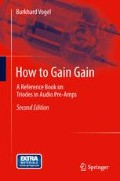Abstract
This chapter tackles all other noise sources of a triode gain stage. It also includes signal-to-noise ratios and A-weighting according to ANSI specs.
Access this chapter
Tax calculation will be finalised at checkout
Purchases are for personal use only
Notes
- 1.
Details see Sect. 3.6.
- 2.
Details see next chapter.
- 3.
RS: see Sect. 3.4.
- 4.
The subscript ‘e’ represents the logarithmic expression of a term; eg. xe = 20 log(x).
- 5.
VISHAY application note AN0003—Table 1 (attention: in this AN it is not specifically indicated that the shown NI figures are given for 1 decade only—but from their values and definition point of view they are all referenced to 1 decade).
- 6.
To demonstrate the extra noise production of any un-bypassed cathode resistance and its negative impact on the input referred noise voltage and SNs in TSOS-2 I use the term Gb/Gu only; µ > 20 makes (1 + µ)/µ close to 1.
- 7.
To emphasize the importance of the input referred noise voltage density of any gain stage in the following sections and chapters I will use ein(f) instead of en.i(f)!
- 8.
- 9.
- 10.
According to the “i” or “j” symbol I'm using the Mathcad style throughout the complete book.
- 11.
Usually, we can find such resistors in the value range from 100Ω up to 10 kΩ. It’s o.k. as long as noise doesn't play any role; in case of noise sensitive designs it has to be taken into account. That's why I include it into all SN calculations.
Author information
Authors and Affiliations
Corresponding author
Rights and permissions
Copyright information
© 2013 Springer-Verlag Berlin Heidelberg
About this chapter
Cite this chapter
Vogel, B. (2013). Noise in Components and Other General Noise Effects. In: How to Gain Gain. Springer, Berlin, Heidelberg. https://doi.org/10.1007/978-3-642-33033-9_3
Download citation
DOI: https://doi.org/10.1007/978-3-642-33033-9_3
Published:
Publisher Name: Springer, Berlin, Heidelberg
Print ISBN: 978-3-642-33032-2
Online ISBN: 978-3-642-33033-9
eBook Packages: EngineeringEngineering (R0)

